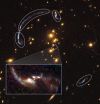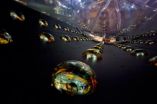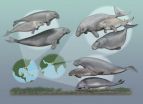(Press-News.org) Thanks to the presence of a natural "zoom lens" in space, University of Chicago scientists working with NASA's Hubble Space Telescope have obtained a uniquely close-up look at the brightest gravitationally magnified galaxy yet discovered.
The imagery offers a visually striking example of gravitational lensing, in which one massive object's gravitational field can magnify and distort the light coming from another object behind it.
Such optical tricks stem from Einstein's theory of general relativity, which describes how gravity can warp space and time, including bending the path that light travels.
In this case, gravity from the galaxy cluster RCS2 032727-132623 bent and amplified the light coming from a much more distant galaxy, 10 billion light-years from Earth. This "gravitational telescope" creates a vast arc of light, as if the distant galaxy had been reflected in a funhouse mirror. The UChicago team reconstructed what the distant galaxy really looks like, using computational tools that reversed the effect of gravitational lensing.
"What's happening here is a manifestation of general relativity," said Michael Gladders, assistant professor in astronomy & astrophysics at UChicago. "Instead of seeing the normal, faint image of that distant source, you see highly distorted, highly magnified, and in this case, multiple images of the source caused by the intervening gravitational mass."
The cosmic lens gave the UChicago team the unusual opportunity to see what a galaxy looked like 10 billion years ago. The reconstructed image of the galaxy revealed regions of star formation glowing like bright points of light. These are much brighter than any star-formation region in Earth's home galaxy, the Milky Way.
'Looking at the nature of dark matter'
In 2006 the Chicago astronomers used the Very Large Telescope in Chile to measure the arc's distance and calculated that the galaxy appears more than three times brighter than previously discovered lensed galaxies. Then last year, Jane Rigby of NASA's Goddard Space Flight Center in Greenbelt, Md., and the Chicago team imaged the arc with the Hubble Space Telescope's Wide Field Camera 3.
Using this gravitational lens as a telescope offers two major scientific opportunities, Gladders said. First, "It gives us a look at that very distant source with a precision and fidelity that we couldn't otherwise achieve," he said.
And second, it provides an opportunity to learn something about the lens-forming mass, which is dominated by dark matter. "It's really a way of looking at the nature of dark matter," Gladders said. Dark matter accounts for nearly 90 percent of all matter in the universe, yet its identity remains one of the biggest mysteries of modern science.
Keren Sharon, a postdoctoral scholar at UChicago's Kavli Institute for Cosmological Physics, led the effort to perform a detailed reconstruction of the lensed galaxy. She and her co-authors, including Gladders, NASA's Rigby and UChicago graduate student Eva Wuyts, published their findings this month in the Astrophysical Journal.
Sharon painstakingly created a computer reconstruction of the gravitational lens, then reverse-engineered the distorted image to determine the distant galaxy's actual appearance. "It's a little bit of an art, but there's a lot of physics in it. That's the beauty of it," Sharon said. "It was a fun puzzle to solve, especially when we had such great data."
Gladders said Sharon is "one of the world experts on exactly how to do this. Combine that degree of finesse with this quality of data, and you get a very nice result. This object now becomes not only the brightest-lensed source known, but because of this analysis, it is also going to be one of the best-understood sources."
Through spectroscopy, the spreading out of light into its constituent colors, the team plans to analyze the distant galaxy's star-forming regions from the inside out to better understand why they are forming so many stars.
The team also has obtained data from one of the twin Magellan Telescopes to help them determine why the galaxy, which is 10 billion light years away, looks so irregular.
"It's not like we have something to compare it to," Sharon said. "We don't know what other galaxies at the same distance look like at this level of detail."
INFORMATION:
Gravitational lens reveals details of distant, ancient galaxy
2012-03-12
ELSE PRESS RELEASES FROM THIS DATE:
Minority administrators, school personnel key to engaging immigrant parents
2012-03-12
Minority principals and other administrative personnel at elementary and high schools play a key role in implementing policies and practices aimed at engaging immigrant parents of students, according to new research from Rice University, the University of Wisconsin–Milwaukee and Vanderbilt University.
The researchers examined how schools in districts with immigrant populations are addressing low levels of parent involvement in their children's education and providing opportunities for engagement and support. The study, which will be published in the March edition of ...
Experiment observes elusive neutrino transformation
2012-03-12
PASADENA, Calif.—An international team of physicists—including several from the California Institute of Technology (Caltech)—has detected and measured, for the first time, a transformation of one particular type of neutrino into another type. The finding, physicists say, may help solve some of the biggest mysteries about the universe, such as why the universe contains more matter than antimatter—a phenomenon that explains why stars, planets, and people exist at all.
The results, released online on March 8, come from the Daya Bay Reactor Neutrino Experiment, which consists ...
Fantazzle Fantasy Sports Games Announce their 2012 Free March Madness College Basketball Bracket & March Madness Salary Cap Games
2012-03-12
Fantazzle Fantasy Sports Games is awarding its community with two different Free March Madness Bracket Games that will be offering several hundred dollars in prizes. The first contest, available for entry now, will be offering $250 in prizes and is the traditional tournament-long bracket. The second bracket will be available for entry shortly after the first bracket game starts and will include the final 32 teams.
"We ran a free bracket game last year that was sponsored by Steiner Sports and it was such a success that we decided to run another game this year. Then, ...
Insect DNA offers tiny clues about animals' changing habitats
2012-03-12
The long-term impact of climate change on natural communities of wild animals could be better understood thanks to a new study.
The research will help predict how migration of animals or changes to their habitats associated with climate change could impact on the evolution of relationships between predators and their prey.
Scientists have shed light on how species and their natural enemies chase each other across continents in a game of cat and mouse lasting for millions of years. They used a technique known as population genetics to reveal historical information hidden ...
Clock gene helps plants prepare for spring flowering, study shows
2012-03-12
Scientists have made fresh discoveries about the processes that govern plants' internal body clocks and help them adjust to changing seasons, triggering the arrival of flowers in spring.
Researchers tested computer models of gene networks in a simple cress plant to determine the role played by a protein, known as TOC1, in governing these daily cycles. The model shows how 12 genes work together to run the plant's complex clockwork, and reset the clock at dawn and dusk each day.
Researchers found that the TOC1 protein, which was previously associated with helping plants ...
Smithsonian scientists discover that multiple species of seacows once coexisted
2012-03-12
Sirenians, or seacows, are a group of marine mammals that include manatees and dugongs; today, only one species of seacow is found in each world region. Smithsonian scientists have discovered that this was not always the case. According to the fossil record of these marine mammals, which dates back 50 million years ago, it was more common to find three, or possibly more, different species of seacows living together at one time. This suggests that the environment and food sources for ancient seacows were also different than today. The team's findings are published in the ...
Avis Israel Offers Unique "On Demand" Car Rental Program for Evenings and Weekends
2012-03-12
Based on successful consumer research conducted through Facebook advertising, Avis Israel has launched its new "On Demand" car rental program. On Demand offers flexible and convenient access to short-term car rentals, without having to register or schedule ahead of time.
Focused on younger, urban drivers who would usually use public transportation or borrow a parents' vehicle, the On Demand program provides an attractive option. Drivers can now rent a car for short periods, ranging in time from only one hour up through a long weekend of Thursday afternoon ...
Radiation oncologists are discussing infertility risks with young cancer patients
2012-03-12
More than 80 percent of radiation oncologists discuss the impact of cancer treatments on fertility with their patients of childbearing age, which can lead to improved quality of life for young cancer patients who are living much longer after their original diagnosis thanks to modern treatment options, according to a study in Practical Radiation Oncology (PRO), the official clinical practice journal of the American Society for Radiation Oncology (ASTRO).
In the past, the clinical focus for young cancer patients was strictly survival. With the success of today's treatment ...
New pig model may lead to progress in treating debilitating eye disease
2012-03-12
LOUISVILLE, Ky. – A newly developed, genetically modified pig may hold the keys to the development of improved treatments and possibly even a cure for retinitis pigmentosa (RP), the most common inherited retinal disease in the United States. The pig model was developed by researchers in the University of Louisville Department of Ophthalmology & Visual Sciences and at the National Swine Resource and Research Center at the University of Missouri.
"We have previously relied mostly on rodent models to study the development and progression of this disease, and although very ...
Teach your robot well (Georgia Tech shows how)
2012-03-12
Within a decade, personal robots could become as common in U.S. homes as any other major appliance, and many if not most of these machines will be able to perform innumerable tasks not explicitly imagined by their manufacturers. This opens up a wider world of personal robotics, in which machines are doing anything their owners can program them to do—without actually being programmers.
Laying some helpful groundwork for this world is, a new study by researchers in Georgia Tech's Center for Robotics & Intelligent Machines (RIM), who have identified the types of questions ...




